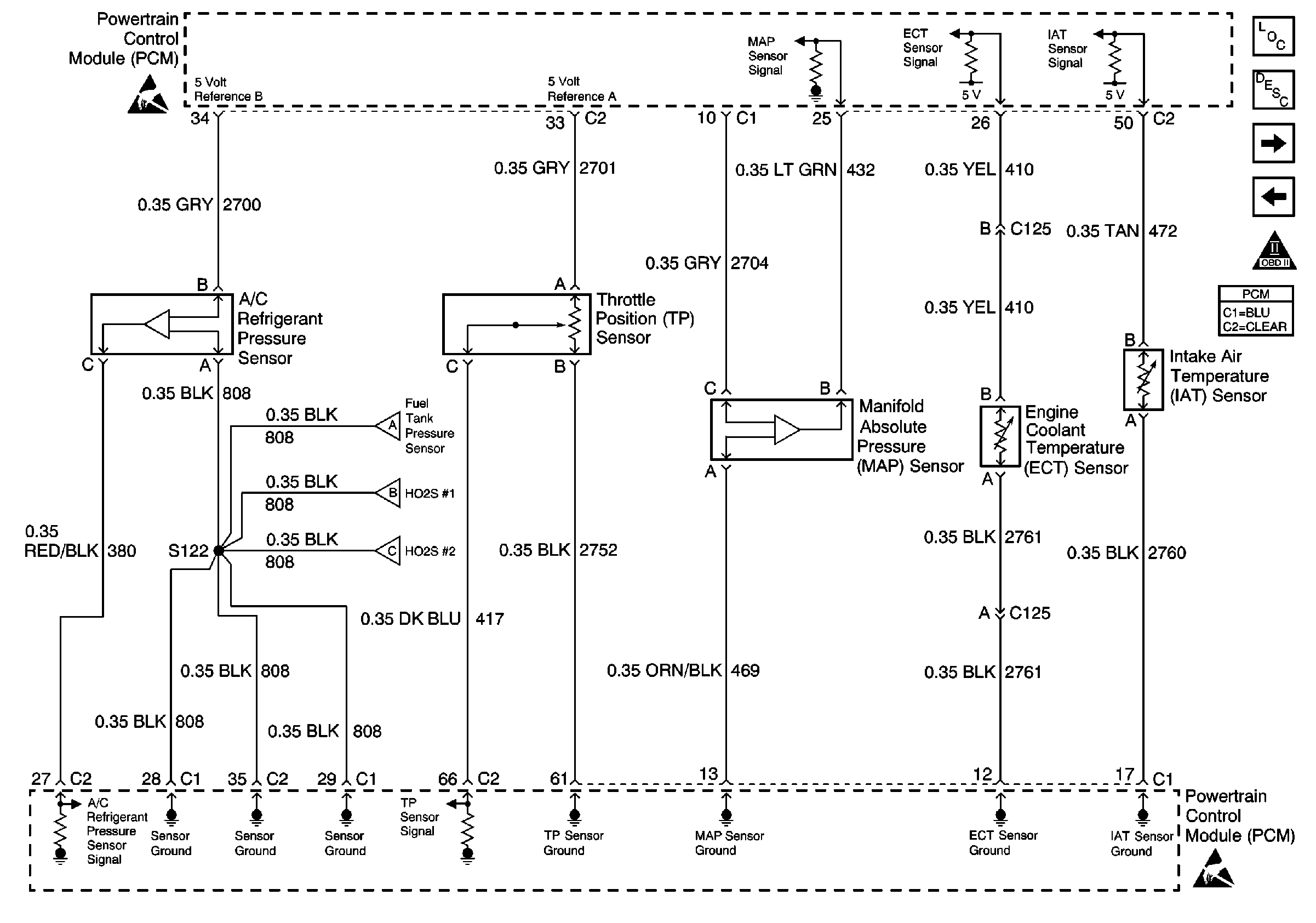Refer to Engine Controls Schematics
A/C Pressure Switch, TPS, MAP, ECT and IAT

.
Circuit Description
The throttle position (TP) sensor is a potentiometer. The TP sensor is mounted on the side of the throttle body. The TP sensor provides a voltage signal that changes relative to throttle blade angle. This signal voltage is one of the most important inputs used by the powertrain control module (PCM). The TP sensor has a 5.0 volt reference, a ground, and a signal circuit. The signal voltage varies from below 1 volt at closed throttle to about 4 volts at wide open throttle (WOT).
Conditions for Running the DTC
The ignition is ON.
Conditions for Setting the DTC
TP sensor intermittently indicates a throttle position signal of more than 4.9 volts.
Action Taken When the DTC Sets
| • | The powertrain control module (PCM) stores the DTC information into memory when the diagnostic runs and fails. |
| • | The malfunction indicator lamp (MIL) will not illuminate. |
| • | The PCM records the operating conditions at the time the diagnostic fails. The PCM stores this information in the Failure Records. |
Conditions for Clearing the MIL/DTC
| • | A History DTC will clear after 40 consecutive warm-up cycles, if no failures are reported by this or any other non-emission related diagnostic. |
| • | The current DTC will clear when the diagnostic runs and does not fail. |
| • | Use a scan tool in order to clear the MIL diagnostic trouble code. |
| • | Interrupting the PCM battery voltage may or may not clear DTCs. This practice is not recommended. Refer to Powertrain Control Module Description , Clearing Diagnostic Trouble Codes. |
Diagnostic Aids
Notice: Use the connector test adapter kit J 35616-A for any test that
requires probing the following items:
• The PCM harness connectors • The electrical center fuse/relay cavities • The component terminals • The component harness connector
Check for the following conditions:
| • | A faulty connection at the PCM or sensor -- Inspect harness connectors for backed out terminals, improper mating, broken locks, improperly formed or damaged terminals, and poor terminal to wire connection. |
| • | A damaged harness -- Inspect the wiring harness for damage. If the harness appears to be OK, observe the throttle position display on the scan tool while moving connectors and wiring harnesses related to the TP sensor. A change in the display will indicate the location of the malfunction. |
| • | Check for a malfunctioning TP sensor. With the key ON and the engine not running, observe the TP sensor display on the scan tool while slowly depressing the accelerator to wide open throttle. If a voltage over 4.71 volts is seen at any point in normal accelerator travel, replace the TP sensor. |
If DTC P1121 cannot be duplicated, reviewing the Failure Records vehicle mileage since the diagnostic test last failed may help determine how often the condition that caused the DTC to be set occurs. This may assist in diagnosing the condition.
If the problem is intermittent, refer to Intermittent Conditions .
Step | Action | Values | Yes | No | ||||||
|---|---|---|---|---|---|---|---|---|---|---|
1 | Did you perform the Powertrain On-Board Diagnostic (OBD) System Check? | -- | ||||||||
2 | Using the scan tool, select DTC Info, Last Test Fail and note any other DTCs that are set. Is DTC P0123 also set? | -- | Go to DTC P0123 Throttle Position (TP) Sensor Circuit High Voltage | |||||||
3 | Is DTC P1111, P1115, and/or P1106 also set? | -- | ||||||||
4 | Check for a faulty sensor ground circuit terminal connection at the TP sensor. Refer to Testing for Intermittent Conditions and Poor Connections in Wiring Systems. Was a problem found? | -- | ||||||||
5 | Check the TP signal circuit between the TP sensor connector and the PCM for an intermittent short to voltage. Refer to Testing for Intermittent Conditions and Poor Connections in Wiring Systems. Was a problem found? | -- | ||||||||
6 | Check for an intermittent short to voltage on the 5 volt reference circuit between the PCM and the following components:
Was a problem found? | -- | ||||||||
7 | Check for a faulty sensor ground terminal connection at the PCM. Refer to Testing for Intermittent Conditions and Poor Connections in Wiring Systems. Was a problem found? | -- | ||||||||
8 | Check for an intermittent open in the sensor ground circuit. Refer to Testing for Intermittent Conditions and Poor Connections in Wiring Systems. Was a problem found? | -- | Go to Diagnostic Aids | |||||||
9 | Replace the malfunctioning harness connector terminal for sensor ground circuit. Refer to Connector Repairs or Wiring Repairs in Wiring Systems. Is the action complete? | -- | -- | |||||||
10 | Repair the intermittent open or short circuit in wiring harness as necessary. Refer to Testing for Intermittent Conditions and Poor Connections in Wiring Systems. Is the action complete? | -- | -- | |||||||
11 |
Does the scan tool indicate that this test ran and passed? | -- | ||||||||
12 | Review Captured Info using the scan tool. Are there any DTCs that have not been diagnosed? | -- | Go to the applicable DTC table | System OK |
